Genesis: A White company design
The White company remains in history for having literally put the US Army on wheels during WWII. It shared this wartime industrial task with Willys-Overland and its iconic Jeep. But while the latter was a true 4x4 car, the White vehicles were more classically-built, light armored trucks. If the M3 Scout Car, first conceived in 1937, shared a strong resemblance with the M2 Half-Tracks, it is no accident. Both were designs of the same bureau. All began in 1936, with a specification issued by the US Army Ordnance for a fast, light armored scout vehicle capable of towing the standard 37 mm (1.46 in) gun of the time. The White Motor Company from Cleveland, which had good experience with trucks chassis, chose one of the sturdiest models it had as a basis, in order to have as much commonality as possible. They mounted larger wheels, which were more suitable for average to bad terrain. In consequence, the first T7 prototype was a compromise, with many civilian features. However, its cost was low, and due to well-proven shared technical parts, reliability was assured. After successful trials in front of the army, the military standard model was issued under the denomination of M3 Scout Car in 1938. Production began soon after.Design and construction
Being based on a commercial truck chassis, the hull could sustain some armored weight. This consisted of face-hardened plates, ranging from 6.4 to 13 mm (0.25-0.51 in) on the later M3A1. This was deemed to be enough, as it could deflect infantry fire. Speed was also seen as active protection. Protection was well distributed around the hull. The radiator was shielded by opening armored shutters and the windshield was made of shatterproof glass. The latter could be covered by a 0.5 inch (12.7 mm) armored plate, which could be swung in place, with two vision slots. The hood could be opened from both sides, and the frontwheels were covered by heavy sheet metal fenders, equipped with standard military taillights coupled with blackout lights. An ax, shovel and pick were mounted under the doors, themselves equipped with folded protective panels pierced with vision slots. Some storage was installed above each rear fender. The rear open-top compartment received 6 bucket seats. The forward compartment was also open-topped. A tarpaulin cover for these was provided.Leaf-spring suspension, non-synchromesh transmission, four-speed manual constant-mesh with one reverse speed and no disengagement were some of the features of White\'s civilian truck. However, the vacuum-assisted brakes were new. The generous, three meter (9.84 ft) wheelbase was completed by a 1.67 m (5.48 ft) tread. The wheels were 220 mm wide, with military 12ply non-directional tires. The engine was also a standard White Hercule JXD 320 cu in L-Head, water-cooled inline six-cylinder, capable of delivering 82 kW (110), with a 6:5:1 compression ratio, and fed by a Zenith model 29 carburetor. Power-to-weight ratio was 19.4 bhp per ton. Fuel capacity was 110 l (30 US gallons), with the fuel tank under the driver seat. Road speed and endurance were good, but off-road capabilities soon revealed to be average at best. So, during its entire career, M3s were usually kept on roads. Only 64 units of the original M3 were produced, and all were given to the 7th Cavalry Brigade.
The M3A1
In 1940 came the much improved M3A1 main production variant. Several modification were implemented. The hull was lengthened, and to prevent bogging down, an unditching roller was mounted in front of the bumper, which remains a trade mark on all the White military vehicles afterwards. As armament was also a concern, three machine guns were mounted on skate rails , one forward central heavy M2 50 cal (12.7 mm) and two 30 cals (7.62 mm) at the rear. They could all be fitted on tripods. A radio was fitted, either a SCR506, 508, or 510, with an antenna base at the center of the rear section. Production started in June 1939 and lasted until early 1944. Total figures differs, from 20,856 to 20,918.The M3A1 became the main road scout in the US Army, serving actively in the Philippines and North Africa. Many were delivered to the Allies, especially the Free French and Russians. However, by 1943 they were seen as obsolete. Critics pointed out the open top compartment, light armour not immune to machine-gun fire, and old-fashion rigid suspension which never allowed them to be fully all-terrain vehicles. Normal duties were rear area road patrols, convoy escort, screening, and, sometimes, advanced scouting parties. All served in various cavalry units throughout the war, but in mid-1942, many were relegated to supply and ambulance work, MP and rear echelon vehicles. By 1943, they had all been replaced by M8 Armored Cars and M20 Utility Cars in their former roles. However, some limited numbers saw action in Normandy and in some /pacific islands, but only for secondary duties.
Video: M3 walkaround
Allied versions and variants
The M3A1E1 was fitted with a new local Buda-Lanova 78 bhp diesel engine, which allowed some increase in operational range. With some minor modification compared to the M3A1, the total production of this version reached 3340 (3034?). All of them were sent and modified in Russia, serving as reconnaissance cars and towing tractors for the ZIS 76 mm (3 in) field artillery. They soldiered well until 1947, and inspired later Soviet designs like the BTR-40. Other versions included the M3A1E2, which had an armored roof, and the M3A1 command car, widely used in North Africa and by the Allies, with improved side armor. One of these was the personal command car of general Patton during this period, equipped with a loud speaker and hooter. The British made good use of the M3, but quickly learned its weaknesses. Polish, Belgian, Czechoslovakian and Free French forces also used it until 1945. The M3A1E3 was a unique prototype equipped with the 37 mm (1.46 in) AT gun, but never reached production.After the war, US Army M3A1s were sent abroad in large quantities, mostly to South America, but also to many African and Asian post-colonial republics. The French deployed them during the Indochina and Algeria war, the last being retired well into the late sixties. They also served in the 1948 Arab-Israeli War. The last still in service by 1990were found in the Dominican Republic regular forces in 1990, a testimony to their sturdiness and simplicity, despite a conception sixty years old.
White Scout Car M3A1 specifications |
|
| Dimensions | 5.6 x 2 x 2 m (18.37x6.56x6.56 ft) |
| Total weight, battle ready | 4 tons |
| Crew | 1+7 |
| Propulsion | Hercules JXD 6cyl gasoline 5200cc, 110 hp - Zenith carburetor |
| Speed | 55 mph (89 km/h) road
36 mph (50 km/h) off-road |
| Range | 400 km at cruise speed |
| Armament | Main: M2 50 cal.(12.7 mm) machine-gun
Secondary: 2xCal.30 M1919A4 machine-guns |
| Armor | From 6 to 13 mm (0.25-0.51 in) |
Links
The White M3 Scout Car on Wikipedia
Superb gallery of a modern M3A1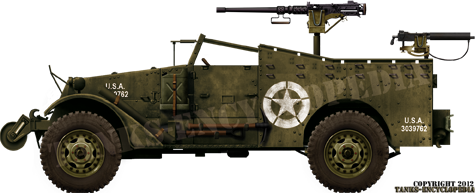
A White M3A1 operating in Tunisia, November 1942, with an early combination of mounts, a central pod heavy 50 cal (12.7 mm) machine-gun, and two rear water-cooled Browning Model 1917A1s.
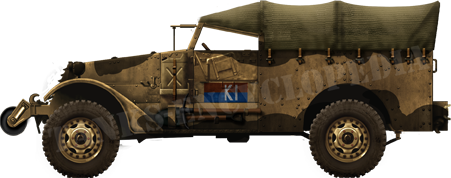
A British VIIIth Army M3A1 Scout Car in May 1942. These were widely used for a variety of missions, with some success, due to their great range, sturdiness and reliability even in these adverse conditions.
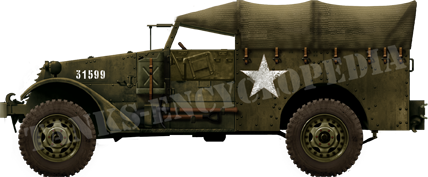
US Army M3, one of the few which were built in 1938. They had no unditching roller and a slightly smaller hull. They all belonged to the US 7th Cavalry Regiment "Garryowen", used for scouting and screening missions throughout 1943-44 years in the Pacific theater.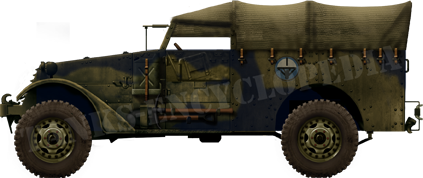
British Army M3A1 in Europe, June 1944. This unit served as a paratrooper transport and recovery vehicle.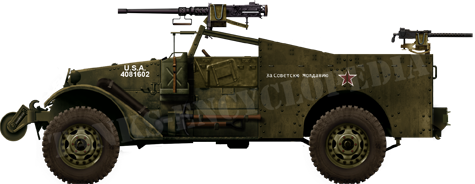
Soviet M3A1E1 on the northern sector, March 1943. The White company provided more than 3000 of these modified versions through Lend-Lease, to be fitted with Buda-Danova diesels on site.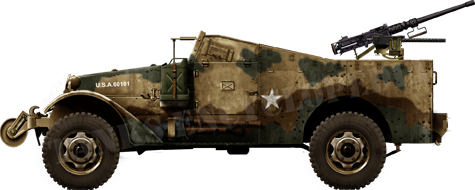
US Army M3A1 Scout Car in Tunisia, May 1943.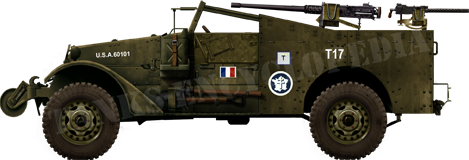
Free French, 2nd D.B. of Gen. Leclerc, August-September 1944.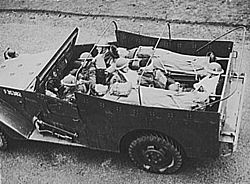
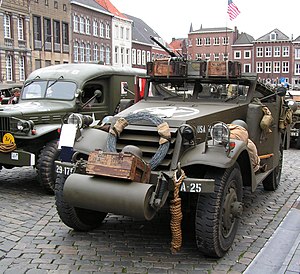
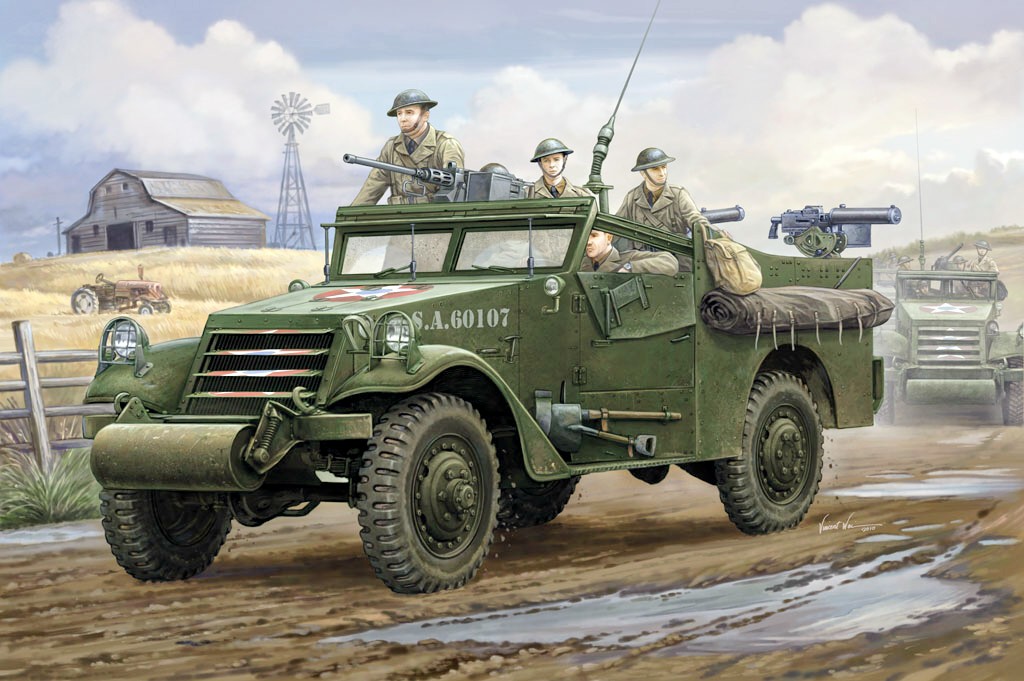
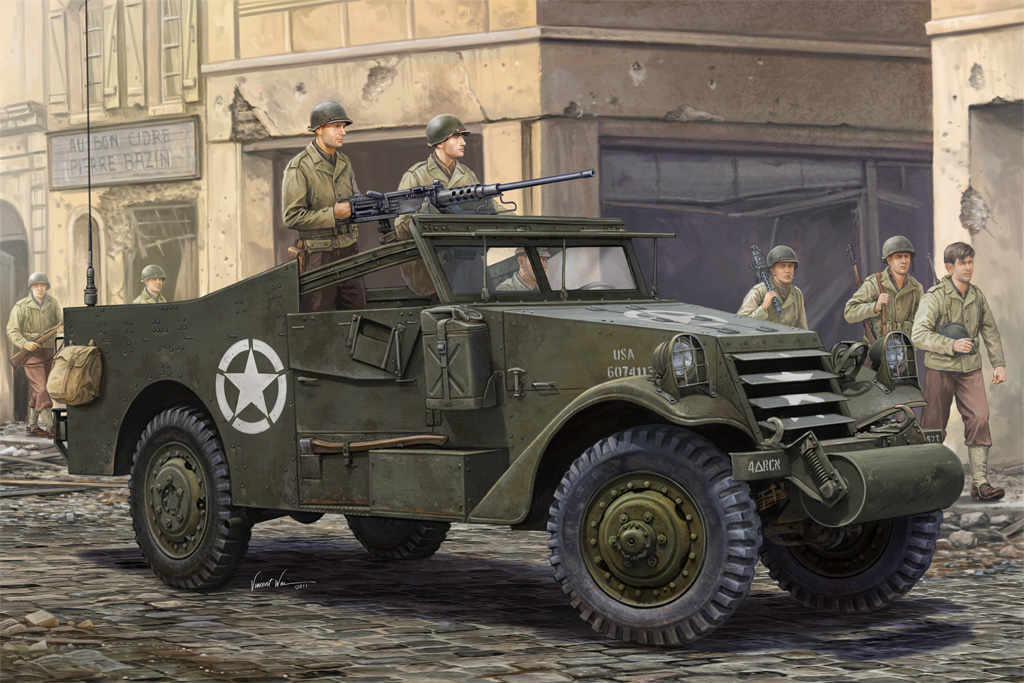
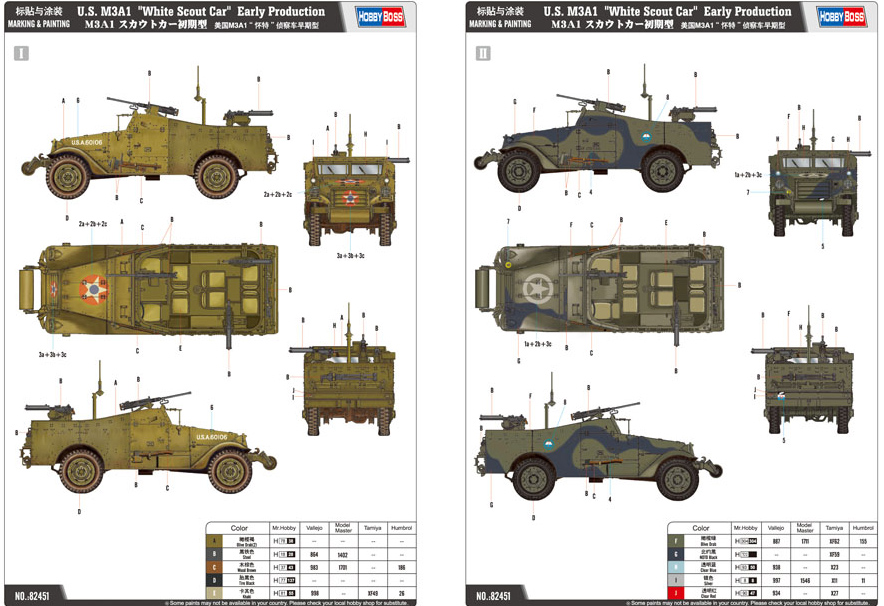
The White M3 Scout Car on Wikipedia
Superb gallery of a modern M3A1

A White M3A1 operating in Tunisia, November 1942, with an early combination of mounts, a central pod heavy 50 cal (12.7 mm) machine-gun, and two rear water-cooled Browning Model 1917A1s.

A British VIIIth Army M3A1 Scout Car in May 1942. These were widely used for a variety of missions, with some success, due to their great range, sturdiness and reliability even in these adverse conditions.

US Army M3, one of the few which were built in 1938. They had no unditching roller and a slightly smaller hull. They all belonged to the US 7th Cavalry Regiment "Garryowen", used for scouting and screening missions throughout 1943-44 years in the Pacific theater.

British Army M3A1 in Europe, June 1944. This unit served as a paratrooper transport and recovery vehicle.

Soviet M3A1E1 on the northern sector, March 1943. The White company provided more than 3000 of these modified versions through Lend-Lease, to be fitted with Buda-Danova diesels on site.

US Army M3A1 Scout Car in Tunisia, May 1943.

Free French, 2nd D.B. of Gen. Leclerc, August-September 1944.
Gallery






WW2 Tanks




























WW2 tanks posters

All Tiger tanks liveries.

Panther liveries and variants

WW2 Armour - All tanks











Tanks aces and single tanks series

Find more there

Museums, Movies, Books & Games
The Tanks and Armor in pop culture
Tanks and armored vehicles in general are only really grasped when seen first person: The mass, the scale, it's all there. Explore also the way tanks were covered in the movie industry, in books and in video games.Movies:
Best tanks movie on warhistoryonline.com
On imdb.com
On bestsimilar.com/
miltours.com
liveabout.com/
watchmojo.com
Video Games:
pcgamesn.com
historyhit.com
levvvel.com
vg247.com/best-tank-games
mmobomb.com/
alienwarearena.com

